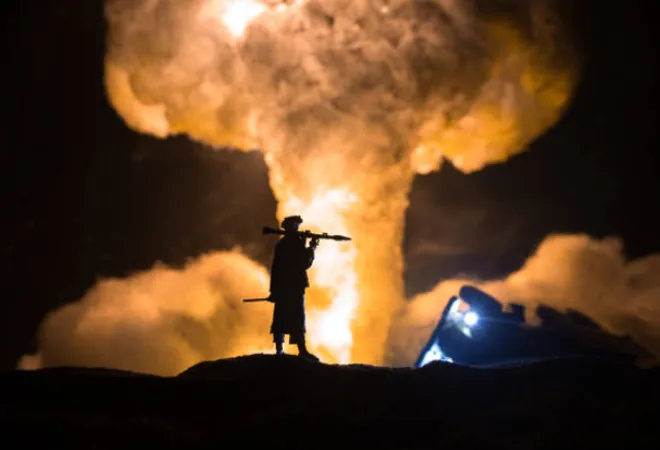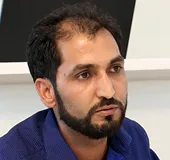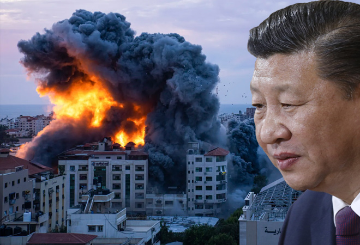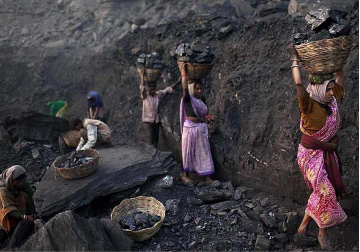 This article is part of ORF's Research and Analyses on the unfolding situation in Afghanistan since August 15, 2021.
This article is part of ORF's Research and Analyses on the unfolding situation in Afghanistan since August 15, 2021.
The dramatic siege of war-torn Afghanistan by a resurgent and emboldened Taliban ahead of the US’ complete withdrawal has increased regional worries about radicalisation, political Islam, and terrorism. The regional powers, including China, Russia, Iran, Pakistan, and India, and even the Shanghai Cooperation Organisation (SCO), have failed to tame the rampaging Taliban without a coherent strategy.
The turn of events in Afghanistan has triggered fresh apprehensions amongst India’s policymakers and security experts of pan-Islamist groups gaining ground support in Kashmir. Though the Taliban maintains its stand that Jammu and Kashmir is a bilateral and internal issue, Pakistan, struggling to come clean of the Financial Action Task Force’s (FATF) grey list, will try to use the situation to spread terror in Jammu and Kashmir to avoid international scrutiny.
Foreign militants in Kashmir after 1989
After the withdrawal of USSR combat forces from Afghanistan in 1989, Pakistan manoeuvred the battle-hardened militants to the Kashmir valley to create a new theatre of conflict and terrorism. The prevalent political environment in the Valley and the anger amongst the people after the rigging of the 1987 legislative assembly elections provided an ideal ground for Pakistan to exploit the situation. Pakistan manipulated the disgruntled Kashmiri youth, favouring armed insurgency to sponsor a “proxy war” against India through an open Line of Control (LoC) with the overt or covert involvement of ISI and other international Islamic organisations. Having repeatedly failed to settle scores with India militarily, Pakistan camouflaged its tactics as a ‘fight for Islam’. It organised a wobbly amorphous crusade into a coherent and organised movement to challenge the Indian state in Kashmir. This is particularly poignant for Pakistan after it was humiliated in the Bangladesh war in 1971, and the regional balance of power swung decisively in India’s favour.
The prevalent political environment in the Valley and the anger amongst the people after the rigging of the 1987 legislative assembly elections provided an ideal ground for Pakistan to exploit the situation.
The ensuing insurgency led to political assassinations and paralysed the government machinery, forcing India to send armed forces to control the situation. It took some time for the security agencies to control the situation, given the presence of many foreign and Kashmiri militants trained in terror camps across the border. According to reports, in August 1993, 400 Afghan insurgents—primarily members of the Hezb-e-Islami party of Gulbuddin Hekmatyar—were present in Kashmir. Between 1989 and 2000, 55,538 incidents of violence were recorded in Jammu and Kashmir and out of the 15,937 militants killed, more than 3,000 were from Pakistan and Afghanistan. Around 40,000 firearms, 150,000 explosive devices, and over 6 million rounds of assorted ammunition were seized during the same period in different counterinsurgency operations.
It took several years for the security agencies to bring a semblance of peace in the Kashmir Valley. The simultaneous increase in surveillance along the LoC led to a decrease in cross-border terrorism. The improving situation allowed the agencies to reduce the number of check posts and military bunkers that had come to dot every nook and cranny of the Valley over the past several years. The elections of September 1996 restored the democratic government. Prime Minister Atal Behari Vajpayee, who remained in power till 2004, reached out to Kashmiris with his philosophy of ‘insaaniyat ke daayre mein’ (in the ambit of humanity). Vajpayee took essential steps to de-escalate the “conflict in Kashmir” through his humanistic approach. He struck a chord with the people of Kashmir, and his strategy worked as a crucial confidence-building measure. He forced the then Chief Minister Mufti Syed to disband the Special Operations’ Groups (SOGs) that had acquired a notorious reputation within Kashmiri society. Many Kashmiris realised that they were merely used by Pakistan for its selfish goals and to seek revenge for the Bangladesh debacle.
Prime Minister Atal Behari Vajpayee, who remained in power till 2004, reached out to Kashmiris with his philosophy of ‘insaaniyat ke daayre mein’ (in the ambit of humanity). Vajpayee took essential steps to de-escalate the “conflict in Kashmir” through his humanistic approach.
Stunned at the palpable mood in the Valley, Pakistan increased the infiltration of terrorists from across the border. Islamabad-based radical terror organisations like Lashkar-e-Taiba (LeT) and Jaish-e-Mohammad (JeM) used the tactics of fidayeen attacks to keep Pakistan’s ill-conceived designs intact and keep Kashmir simmering. Between mid-1999 and the end of 2002, Kashmir witnessed 55 fidayeen attacks, executed mainly by Pakistani insurgents. With an increasing number of local youth getting weaned away from militancy, the year-wise causality of Pakistani or foreign militants rose exponentially after 2002, as shown in Figure 1.
Return of Taliban and Kashmir
As in 1989, Islamabad will try to use the resurgence of the Taliban in Afghanistan to send insurgents to Kashmir. According to reports, thousands of Pakistani terrorists from Lashkar-e-Taiba (LeT), Jaish-e-Mohammed (JeM), and other terror outfits groups are currently fighting alongside the Taliban. They will be ready and willing to infiltrate into the Kashmir Valley. However, the Kashmir of today is not what it was in 1989. Over the years, the internal security grid has been beefed up, surveillance along the LoC has vastly improved with drones and night-vision cameras, and the abrogation of Article 370 and 35A in 2019 has put the newly-carved Union Territory under the direct control of the Central Government. Additionally, Pakistan has been shamed internationally as the FATF grey listing since June 2018 has exposed its covert support to international terrorism. Already facing the heat for its actions, Pakistan will find it difficult to replicate its devious tactics to unleash fresh discord in the Valley.
Heightened security along the LoC has led to a noticeable reduction in the presence of foreign terrorists in the Valley. For example, in 2019, 130 infiltrations were recorded across the LoC, while only 30 managed to infiltrate into the Kashmir Valley from January to October 2020. The effective shutting down of the LoC route for infiltrations has driven Pakistan’s military establishment and the ISI to desperate means, including narco-terrorism via the Wagah border and the use of drones to drop weapons along the Indian side of the LoC. In June 2020, the Border Security Force (BSF) shot down a Pakistani drone in the Kathua district of Jammu region near the international border. The drone carried four batteries, two Global Positioning Systems (GPS), seven Chinese grenades, and a sophisticated US-made M4 semi-automatic carbine.
The effective shutting down of the LoC route for infiltrations has driven Pakistan’s military establishment and the ISI to desperate means, including narco-terrorism via the Wagah border and the use of drones to drop weapons along the Indian side of the LoC.
Another change between 1989 and now is the increasing fatigue felt by people living endlessly under the shadow of the gun. While the sense of perceived victimhood and peer pressure that emanates from the “emotional pull to act in the face of injustice and humiliation” continues to fester anti-India sentiments, monotony from violence is reflected in the reducing number of stone-pelting incidents, calls for strike and protests at encounter sites. According to official data, Kashmir witnessed only 255 stone-pelting incidents in 2020 compared to 1,999 in 2019, 1,458 in 2018, and 1,412 in 2017.
However, even as India seems to have adequately upgraded its tactical preparedness to thwart Pakistan’s external attempts, the real worry lies internally within Kashmir. Set to establish an Islamic government in Afghanistan interwoven with a tribal culture and to renew its idea of establishing the Caliphate from Afghanistan to the European border, the rejuvenated Taliban can reignite violent sentiments in a section of the Kashmiri youth with deviant behaviour. The unending conflict over Kashmir has created political and social ruptures in the Kashmiri society, sounding the death knell for the Valley’s traditional social orders and social control systems. Even if Pakistan achieves a degree of success in its evil designs, the deviant youth are capable of silencing the more significant section of society within Kashmir, which still believes in Kashmiriyat, the unique syncretic, devotional and philosophical ‘Kashmiri’ way of life.
Pakistan can exploit these sentiments and the prevalent fear and suspicion of identity and culture after the abrogation of Article 370 and 35A to “implement” radicalisation in the Kashmir valley from across the border through the Taliban. It will also use the widespread dissatisfaction and anger against India and the simmering sense of perceived victimhood within the Valley to incite further anger and violence. Such a scenario can blunt New Delhi’s integrational approach. Therefore, New Delhi must see the happenings in Afghanistan as an opportunity to kick start sincere and result-oriented interlocution with the people of the Valley. It must provide clean and fair administration and ensure the safety of the Kashmiri identity and culture. The absence of such positive political outreach will facilitate Pakistan, which is keen to abuse the turn of events in Afghanistan to its benefit.
The views expressed above belong to the author(s). ORF research and analyses now available on Telegram! Click here to access our curated content — blogs, longforms and interviews.



 This article is part of ORF's
This article is part of ORF's  PREV
PREV


